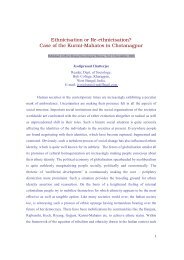Chapter 5 - WebRing
Chapter 5 - WebRing
Chapter 5 - WebRing
Create successful ePaper yourself
Turn your PDF publications into a flip-book with our unique Google optimized e-Paper software.
CHAPTER 5. MAGNETIC SYSTEMS 267<br />
summarized by the follow steps.<br />
1. Choose a spin at random and make a trial flip. Compute the energy before, E1, and after<br />
the flip, E2, and accept the change with probability<br />
p(E1 → E2) = min( ˜ Ω(E1)/ ˜ Ω(E2),1), (5.131)<br />
where ˜ Ω(E) is the current estimate of Ω(E). Equation (5.131) implies that if ˜ Ω(E2) ≤<br />
˜Ω(E1), the state with energy E2 is alwaysaccepted; otherwise, it is accepted with probability<br />
˜Ω(E1)/ ˜ Ω(E2). That is, the state with energy E2 is accepted if a random number r satisfies<br />
the condition r ≤ ˜ Ω(E1)/ ˜ Ω(E2). After the trial flip the energy of the system is E2 if the<br />
change is accepted or remains at E1 if the change is not accepted.<br />
2. To estimate Ω(E) multiply the current value of ˜ Ω(E) by a modification factor f > 1:<br />
˜Ω(E) = f ˜ Ω(E). (5.132)<br />
We also update the existing entry for H(E) in the energy histogram<br />
H(E) → H(E)+1. (5.133)<br />
Because ˜ Ω(E) becomes very large, we must work with the logarithm of the density of states,<br />
so that ln ˜ Ω(E) will fit into double precision numbers. Therefore, each update of the density<br />
of states is implemented as ln ˜ Ω(E) → ln ˜ Ω(E)+lnf, and the ratio of the density of states is<br />
computed as exp[ln ˜ Ω(E1)−ln ˜ Ω(E2)]. A reasonable choice of the initial modification factor<br />
is f = f0 = e ≈ 2.71828.... If f0 is too small, the random walk will need a very long time to<br />
reach all possible energies. Too large a choice of f0 will lead to large statistical errors.<br />
3. Proceed with the random walk in energy space until an approximately flat histogram H(E)<br />
is obtained, that is, until all the possible energy values are visited an approximately equal<br />
number of times. Because it is impossible to obtain a perfectly flat histogram, we will say<br />
that H(E) is “flat” when H(E) for all possible E is not less than ∆ of the average histogram<br />
H(E); ∆ is chosen according to the size and the complexity of the system and the desired<br />
accuracy of the density of states. For the two-dimensional Ising model on small lattices, ∆<br />
can be chosen to be as high as 0.95, but for large systems the criterion for flatness might<br />
never be satisfied if ∆ is too close to 1.<br />
4. Oncetheflatnesscriterionhasbeensatisfied,reducethemodificationfactorf usingafunction<br />
such as f1 = √ f0, reset the histogram to H(E) = 0 for all values of E, and begin the next<br />
iteration of the random walk during which the density of states is modified by f1 at each<br />
trial flip. The density of states is not reset during the simulation. We continue performing<br />
the random walk until the histogram H(E) is again flat. We then reduce the modification<br />
factor, fi+1 = √ fi, reset the histogram to H(E) = 0 for all values of E, and continue the<br />
random walk.<br />
5. Thesimulationisstopped whenf is smallerthan apredefinedvalue[suchasf = exp(10 −8 ) ≈<br />
1.00000001]. The modification factor acts as a control parameter for the accuracy of the<br />
density of states during the simulation and also determines how many Monte Carlo sweeps<br />
are necessary for the entire simulation.

















